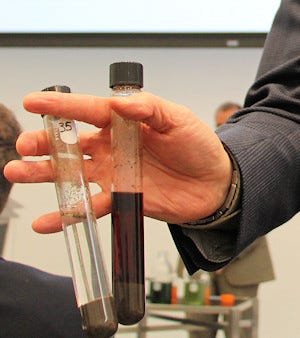January 26, 2016

A new mindset is abuzz in farming: Rather than broadcast-spray fertilizer and other crop inputs onto the field, why not place them in the seed furrow where they can be accessed by the seed to get the crop off to a good start?
The practice is called in-furrow application, and some say it is the one of the fastest-growing trends in agriculture.
“Today, we believe about 25% of corn acres are getting in-furrow application, and more products and technologies are getting applied,” says Dean Hendrickson, vice president of marketing and business development at West Central, a wholesale distributor of crop inputs. “And whether it is Minnesota, Nebraska or Iowa, or other Midwest states, we are seeing a trend toward more acres utilizing in-furrow applications.”
Hendrickson says the in-furrow market is expected to double to 50% of the acres by 2020.
In 2012, West Central - in partnership with BASF Corp., Dow AgroSciences, FMC and Nufarm - started Leaders of In-Furrow Technology (LIFT), a program designed to educate growers and retailers on the benefits of in-furrow application. West Central held a two-day conference in October on the topic. A number of factors are driving the trend to in-furrow, Hendrickson says.
“There is a segment of growers that do not use any starter fertilizer and rely upon their fall or spring broadcast applications for germination,” he says. “However, due to earlier planting dates in cooler soils, coupled with increased seed investments, the trend to in-furrow is growing.”
Putting fertilizer and chemicals inside the seed furrow helps protect the seed at a critical stage in the growth cycle, experts say. Protecting the seed early on can help it achieve its genetic potential.
“A seed is like a baby,” says Brian Kuehl, West Central’s director of product development. “You want to make sure that seed is protected and cared for. You need to provide the proper nutrition, but also protect it against outside factors, such as cold and disease.”
The claims have some merit. Fred Below, a University of Illinois researcher and crop physiologist, says protecting and nourishing corn early is important for high yields. “A plant senses its nutrition at an early stage and grows accordingly. If it starts strong, it gives you the best chance for higher yield.
“You really have only one chance to get the plant off to rapid start,” Below says. “When you put seed in the ground, you want to make sure it has the best possible experience and the best possible growth from the very beginning.
“We also are starting to see the synergistic effect of where a fungicide combined with an insecticide and a starter fertilizer enhances and protects the plant or seedling growth,” Below says. “And having the nutrients there can start the plant off on a faster growth trajectory.”
Beyond fertilizer
In-furrow application has been commonly used in small grains to apply fertilizer. But its use is spreading to other crops, such as corn and soybeans, and to other types of inputs, such as fungicides, insecticides, micronutrients, plant growth regulators and biologicals.

The test tubes demonstrate what happens when West Central’s chelating agent Levesol is applied to the soil. The test tube on the left is soil mixed with deionized water. The tube on the right is soil mixed with water and Levesol. Levesol makes micronutrients in the soil, including zinc, iron, copper and manganese immediately soluble so they can be absorbed by the plant.
This creates a big business for companies selling the products. West Central says dealers can earn upward of $10 per acre by selling in-furrow products.
But farmers are benefiting, too, with more efficient use of crop inputs. For example, last year West Central launched a chelating agent called Levesol, which is designed to improve plant uptake of phosphorus and micronutrients. It works by keeping the micronutrients in a soluble form so they are not bound up in the soil.
Dow AgroSciences’ N-serve and Instinct II nitrogen stabilizer inhibit nitrification and keep nitrogen at the root zone.
As for fungicides and insecticides for in-furrow application, BASF says its new Xanthion in-furrow fungicide incorporates a built-in biological that makes the product’s chemical agent work better and last longer. Xanthion has Headline as the base, combined with the only EPA-registered biological.
FMC’s Ethos XB, also for in-furrow application, is used as both an insecticide and fungicide. The product controls insects and contains a biofungicide that kills fungus.
Not a slam dunk
In-furrow application won’t replace broadcast spraying. Sometimes rescue treatments can be just what the doctor ordered. As with any practice, caution must be used, especially with fertilizer. The most common issue is salt.
Mike Stewart, regional director of the International Plant Nutrition Institute, says in-furrow fertilization can result in seedling damage, and ultimately stand and yield loss if overapplied or mismanaged. “Fertilizers are salts, and these salts can affect the ability of the seedling to absorb water,” he says. “Too much fertilizer, or ‘salt,’ and desiccation, or ‘burn,’ can occur. ”
Stewart advises growers to check with their fertilizer dealer or Extension resources to ensure the proper salt index for their crop and soil type.
Tech advancing
New products and technologies are addressing these and other issues. West Central’s Hendrickson says the advancement of premium starter fertilizers, such as Redline, essentially eliminate the risk with high-salt fertilizers.
Research is also going on in the areas of phosphorus efficiency, nutrient uptake and biologicals.
“There have been a number of new products/innovations in the in-furrow field, and in particular, advancements in nutrient efficiency, as well as the use of biological compounds,” says Hendrickson. “We expect this to continue to increase significantly in the future.”
Buyer's Guide
Here are a few products designed for in-furrow use, which are part of the LIFT initiative.
West Central
• Levesol chelating agent improves nutrient uptake in crops.
• Soygreen chelating agent keeps iron more available for uptake .
• Redline starter fertilizer prevents phosphate imbalance.
Learn more at inthefurrow.com/partners/west-central.
BASF
• Priaxor Fungicide enhances root growth and seedling vigor, and improves cold tolerance.
• Xanthion Fungicide combines biological and chemical modes of action to deliver longer-lasting residual disease control.
Learn more at inthefurrow.com/partners/basf-corporation.
FMC
• Capture LFR is a soil insecticide in a liquid-fertilizer-ready (LFR) formulation.
• Ethos XB is a new soil insecticide and fungicide in an LFR formulation.
Learn more at inthefurrow.com/partners/fmc.
Dow AgroSciences
• N-Serve, a nitrogen stabilizer, is used with anhydrous ammonia.
• Instinct II nitrogen stabilizer can be used with UAN, urea or manure.
Learn more at inthefurrow.com/partners/dow-agrosciences.
Nufarm seed treatments
• Sativa 309 FS, IM Max, IMF Max, IM RTU, M RTU
• Sebring 318 FS, 480 FS
• Senator 600 FS
• Signet 480 FS
• Spirato 480
• ST-Methyl 540
Learn more at inthefurrow.com/partners/nufarm.
About the Author(s)
You May Also Like




